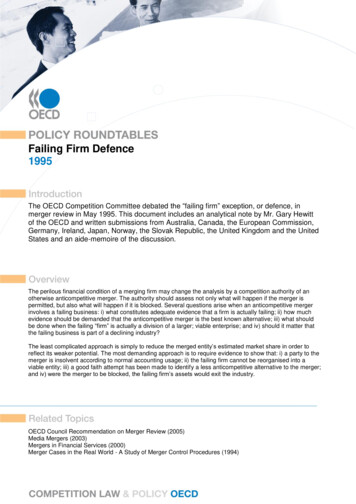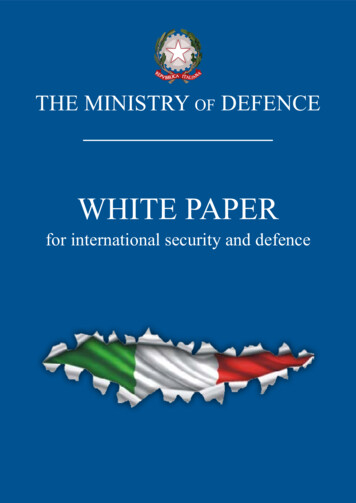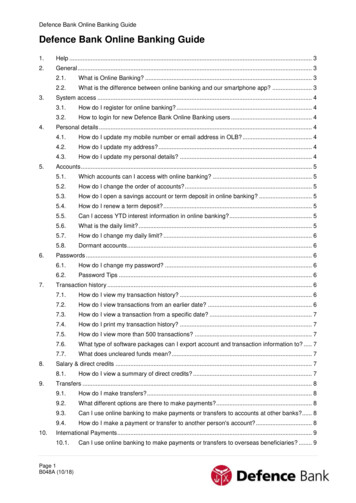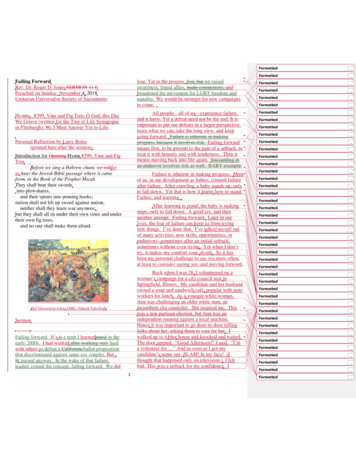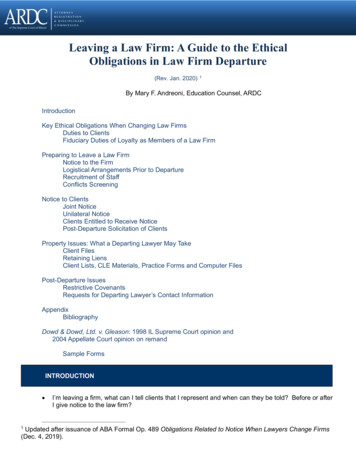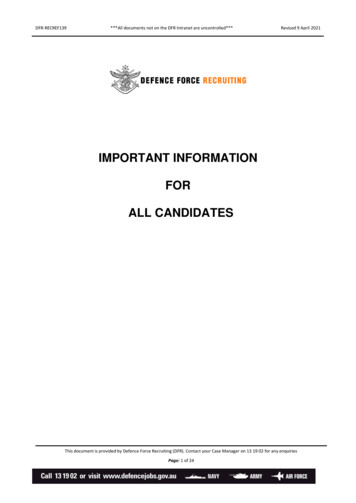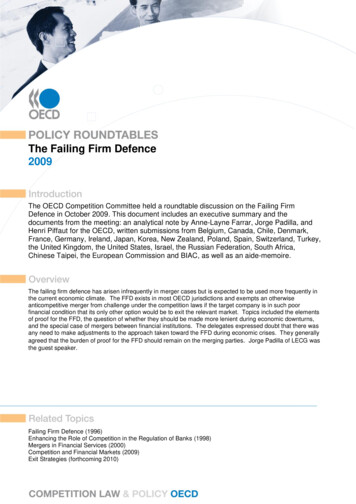
Transcription
The Failing Firm Defence2009The OECD Competition Committee held a roundtable discussion on the Failing FirmDefence in October 2009. This document includes an executive summary and thedocuments from the meeting: an analytical note by Anne-Layne Farrar, Jorge Padilla, andHenri Piffaut for the OECD, written submissions from Belgium, Canada, Chile, Denmark,France, Germany, Ireland, Japan, Korea, New Zealand, Poland, Spain, Switzerland, Turkey,the United Kingdom, the United States, Israel, the Russian Federation, South Africa,Chinese Taipei, the European Commission and BIAC, as well as an aide-memoire.The failing firm defence has arisen infrequently in merger cases but is expected to be used more frequently inthe current economic climate. The FFD exists in most OECD jurisdictions and exempts an otherwiseanticompetitive merger from challenge under the competition laws if the target company is in such poorfinancial condition that its only other option would be to exit the relevant market. Topics included the elementsof proof for the FFD, the question of whether they should be made more lenient during economic downturns,and the special case of mergers between financial institutions. The delegates expressed doubt that there wasany need to make adjustments to the approach taken toward the FFD during economic crises. They generallyagreed that the burden of proof for the FFD should remain on the merging parties. Jorge Padilla of LECG wasthe guest speaker.Failing Firm Defence (1996)Enhancing the Role of Competition in the Regulation of Banks (1998)Mergers in Financial Services (2000)Competition and Financial Markets (2009)Exit Strategies (forthcoming 2010)
UnclassifiedOrganisation de Coopération et de Développement ÉconomiquesOrganisation for Economic Co-operation and DevelopmentDAF/COMP(2009)3810-Aug-2010English, FrenchDIRECTORATE FOR FINANCIAL AND ENTERPRISE AFFAIRSCOMPETITION COMMITTEEDAF/COMP(2009)38UnclassifiedROUNDTABLE ON FAILING FIRM DEFENCEEnglish, FrenchJT03287312Document complet disponible sur OLIS dans son format d'origineComplete document available on OLIS in its original format
DAF/COMP(2009)382
DAF/COMP(2009)38FOREWORDThis document comprises proceedings in the original languages of a Roundtable on Failing FirmDefence held by the Competition Committee in October 2009.It is published under the responsibility of the Secretary General of the OECD to bringinformation on this topic to the attention of a wider audience.This compilation is one of a series of publications entitled "Competition Policy Roundtables".PRÉFACECe document rassemble la documentation dans la langue d'origine dans laquelle elle a étésoumise, relative à une table ronde sur l‘entreprise défaillante qui s'est tenue en octobre 2009 dans le cadredu Comité de la concurrence.Il est publié sous la responsabilité du Secrétaire général de l'OCDE, afin de porter à laconnaissance d'un large public les éléments d'information qui ont été réunis à cette occasion.Cette compilation fait partie de la série intitulée "Les tables rondes sur la politique de laconcurrence".Visit our Internet Site -- Consultez notre site Internethttp://www.oecd.org/competition3
DAF/COMP(2009)384
DAF/COMP(2009)38OTHER TITLESSERIES ROUNDTABLES ON COMPETITION n Policy and EnvironmentFailing Firm DefenceCompetition Policy and Film DistributionCompetition Policy and Efficiency Claimsin Horizontal AgreementsThe Essential Facilities ConceptCompetition in TelecommunicationsThe Reform of International Satellite OrganisationsAbuse of Dominance and MonopolisationApplication of Competition Policy to High Tech MarketsGeneral Cartel Bans: Criteria for Exemption for Small andMedium-sized EnterprisesCompetition Issues related to SportsApplication of Competition Policy to the Electricity SectorJudicial Enforcement of Competition LawResale Price MaintenanceRailways: Structure, Regulation and Competition PolicyCompetition Policy and International Airport ServicesEnhancing the Role of Competition in the Regulation of BanksCompetition Policy and Intellectual Property RightsCompetition and Related Regulation Issuesin the Insurance IndustryCompetition Policy and Procurement MarketsRegulation and Competition Issues in Broadcasting in the lightof ConvergenceRelationship between Regulators and Competition AuthoritiesBuying Power of Multiproduct RetailersPromoting Competition in Postal ServicesOligopolyAirline Mergers and AlliancesCompetition in Professional ServicesCompetition in Local ServicesMergers in Financial ServicesPromoting Competition in the Natural Gas IndustryCompetition Issues in Electronic P(2000)32
60.61.62.63.64.65.66.67.68.69.70.Competition and Regulation Issuesin the Pharmaceutical IndustryCompetition Issues in Joint VenturesCompetition Issues in Road TransportPrice TransparencyCompetition Policy in Subsidies and State AidPortfolio Effects in Conglomerate MergersCompetition and Regulation Issues in TelecommunicationsMerger Review in Emerging High Innovation MarketsLoyalty and Fidelity Discounts and RebatesCommunication by Competition AuthoritiesSubstantive Criteria used for the Assessment of MergersCompetition Issues in the Electricity SectorMedia MergersNon Commercial Services Obligations and LiberalisationCompetition and Regulation in the Water SectorRegulating Market Activities by Public SectorMerger RemediesCartels: Sanctions against IndividualsIntellectual Property RightsPredatory ForeclosureCompetition and Regulation in Agriculture:Monopsony Buying and Joint SellingEnhancing Beneficial Competition in the Health ProfessionsEvaluation of the Actions and Resourcesof Competition AuthoritiesStructural Reform in the Rail IndustryCompetition on the MeritsResale Below Cost Laws and RegulationsBarriers to EntryProsecuting Cartels without Direct Evidence of AgreementThe Impact of Substitute Services on RegulationCompetition in the Provision of Hospital ServicesAccess to key Transport FacilitiesEnvironmental Regulation and CompetitionConcessionsRemedies and SanctionsCompetition in Bidding MarketsCompetition and Efficient Usage of Payment cardsVertical mergersCompetition and Regulation in Retail BankingImproving Competition in Real Estate COMP(2007)36
99.100.101.102.Public Procurement – The Role of Competition Authoritiesin Promoting CompetitionCompetition, Patents and InnovationPrivate RemediesEnergy Security and Competition PolicyPlea Bargaining Settlement of Cartel CasesCompetitive Restrictions in Legal ProfessionsDynamic Efficiencies in Merger AnalysisGuidance to Business on Monopolisation and Abuse of DominanceThe Interface between Competition and Consumer PoliciesFacilitating Practices in OligopoliesTaxi Services Regulation and CompetitionTechniques and Evidentiary Issues in Proving Dominance/Monopoly PowerManaging Complex Merger CasesPotential Pro-Competitive and Anti-Competitive Aspects ofTrade/Business AssociationsMarket StudiesLand Use Restrictions as Barriers to EntryConstruction IndustryAntitrust Issues Involving Minority Shareholding andInterlocking DirectoratesBundled and Loyalty Discounts and RebatesTechniques for Presenting Complex Economic Theoriesto JudgesCompetition Policy for Vertical Relations in Gasoline RetailingCompetition and Financial MarketsRefusals to DealResale Price MaintenanceExperience with Direct Settlements in Cartel CasesCompetition Policy, Industrial Policy and National ChampionsTwo-Sided MarketsMonopsony and Buyer PowerCompetition and Regulation in Auditing and Related ProfessionsRoundtable on competition policy and the informal economyCompetition, Patents and InnovationThe Standard for Merger Review, with a Particular Emphasis onCountry Experience with the change of Merger Review Standardfrom the Dominance Test to the SLC/SIEC P(2009)22DAF/COMP(2009)21
DAF/COMP(2009)388
DAF/COMP(2009)38TABLE OF CONTENTSEXECUTIVE SUMMARY .11SYNTHÈSE.15BACKGROUND NOTE .19NOTE DE REFERENCE .47CONTRIBUTIONSBelgium .79Canada .83Chile .89Denmark .93France .99Germany .105Ireland .111Japan .119Korea .123New Zealand .129Poland .137Spain .141Switzerland .147Turkey .151United Kingdom .161United States .175European Commission .183andIsrael .189Russian Federation .193South Africa .195Chinese Taipei .197OTHERBIAC .201SUMMARY OF DISCUSSION .209COMPTE RENDU DE LA DISCUSSION .2179
DAF/COMP(2009)3810
DAF/COMP(2009)38EXECUTIVE SUMMARYBy the SecretariatConsidering the discussion at the roundtable, the delegates‘ written submissions and the Secretariat‘sbackground paper, several key points emerge:(1)The failing firm defence (FFD) may arise more frequently during financial and economic crises.During economic crises such as the one that most OECD countries are currently experiencing,more firms may find themselves in financial difficulty. Some financially distressed companieswill seek to improve their condition by merging with healthier competitors. Competitionagencies may therefore face an increasing number of merger reviews involving financiallytroubled firms, some of which may be true failing firms while others may simply be weakcompetitors. In some of the cases, parties may put the FFD forward as an argument in favour ofapproving their transaction.(2)The basic conditions required for a successful application of the FFD are relatively similaracross countries.A merger that is expected to lead to anti-competitive effects should be prohibited when there is acausal link between the merger and the anticipated harm to competition. When one of themerging firms is ‗failing‘ (i.e. it is likely to exit the market absent the merger), the futuredeterioration in competitive conditions does not necessarily result from the transaction and hencethe causal link may be missing. In some circumstances, the post-merger scenario may be lessanti-competitive than a counterfactual scenario in which the failing firm exited the market. Inthose cases, mergers involving failing firms should be approved even when the post-mergerscenario is less competitive than the pre-merger scenario.Although there are small differences between the approaches adopted by different competitionauthorities when applying the FFD, they all require three cumulative conditions before acceptinga failing firm defence: Absent the merger, the failing firm will exit the market in the near future as a result of itsfinancial difficulties; There is no feasible alternative transaction or reorganisation that is less anti-competitivethan the proposed merger; and Absent the merger, the assets of the failing firm would inevitably exit the market.The burden of proof to show that these conditions are fulfilled lies on the merging parties. Theyshould convince the competition authority that the merger will lead to less anti-competitiveeffects than a counterfactual scenario in which the firm and its assets would exit the market.11
DAF/COMP(2009)38One notable difference among jurisdictions is that some consider whether the failure of the firmand the liquidation of its assets could be a less anticompetitive alternative to the merger since theremaining firms in the market might compete for both the failing firm's market share and theassets that otherwise would have been transferred entirely to one purchaser. In particular, there ispresently a difference of views between the stated policies of some national Europeancompetition agencies and the European Commission. The Commission has moved away fromthe requirement that absent the merger all the failing firm market share should accrue to theacquirer, but several EU countries have not yet reflected this change in their policies. The lowfrequency of the FFD and the gradual development of policy through case law may explain thelag.(3)Not all countries have a formal FFD, but those that do have one consider it to provide legalcertainty.A few countries do not have explicit failing firm defences. In these countries, mergers involvinga failing firm are reviewed using the standard causality test in merger control. If appliedproperly, such a test would identify those transactions that should be approved despite their anticompetitive effects. However, such an approach may be difficult and costly to administer andmay lead to less predictable outcomes. Those countries with an explicit FFD have found that (a)it yields outcomes that are broadly similar to the outcomes that would obtain under the properlyapplied traditional causality test and (b) it provides predictability for firms that are subject tomerger control regimes.(4)Failing division defences should be subject to standards that are similar to the FFD standards,but that are applied differently in light of factual differences between failing divisions and failingfirms.In some instances, the merger under review involves the acquisition of a firm‘s division. In thosecases, the merging parties may argue that the exit of that particular division from the marketwould occur (i) whether or not the merger materialises and (ii) irrespective of the financial healthof the parent company. While most countries are open to the application of this so-called failingdivision defence (FDD), competition authorities should be aware of the possibility that parentcompanies may employ creative accounting methods to establish the illusion of a failingdivision. A division that is not currently profitable will not necessarily exit the marketimminently. The losses may be temporary, and in any event the division may be importantenough to the parent company that it would be unlikely to exit even if the losses continue. It maybe difficult to assess the amount of money that the parent would invest in the division absent themerger, though. Consequently, parties should be required to produce clear evidence that, withoutthe merger, the division would be likely to fail and its assets would be likely to exit the marketimminently.(5)The FFD criteria should not be relaxed in times of crisis. There may, however, be some room forstreamlining the FFD review process.As of October 2009, competition authorities had not seen an increase in the number of mergers inwhich the parties claimed the FFD. This may be because there is a perception that the FFDcriteria are too strict. That raises the question whether competition authorities should loosen theFFD criteria, particularly in light of the current global economic crisis. The consensus among theCommittee delegates was that there is no justification for such a change. There are other policy12
DAF/COMP(2009)38instruments (e.g. bankruptcy law and State aid) available to help failing firms through the crisis.Competition authorities are concerned that excessively lax standards may lead to too many typeII errors, i.e. false negatives.Nevertheless, competition authorities recognise that FFD investigations may be too lengthy,which is problematic given that the position of firms in distress may rapidly deteriorate, which inturn may cause inefficient liquidations. This may justify procedural changes to ensure a speedierreview of mergers involving failing firms.(6)Whereas not all delegates agreed that mergers involving financial institutions deserve specialtreatment, they did agree that systemic risk considerations should be taken into account inmerger proceedings.Banks are special economic agents because of their importance for the stability of the financialsystem and the economy. The collapse of one key bank may have a domino effect that leads towidespread loss of confidence in the financial system and thus to a severe economic recession.All countries acknowledge the importance and the special role of banks in their economies. Evenso, while some countries do not consider that mergers involving failing financial institutionsshould be treated differently, others are prepared to treat mergers amongst financial institutionsmore leniently when bank failure is a possibility. Those against the special treatment of bankmergers argue that competition authorities should focus on promoting and preservingcompetition and leave prudential regulation to the Central Bank.Some competition agencies argue that it may be more difficult to succeed with a FFD in mergersinvolving banks. This is because they anticipate that governments may intervene with some kindof financial support in order to prevent the failing bank from leaving the market. In other words,they consider that the assets of failing banks are unlikely to exit the market in practice.13
DAF/COMP(2009)3814
DAF/COMP(2009)38SYNTHÈSEpar le SecrétariatCompte tenu des débats ayant eu lieu au cours de la table ronde, des contributions écrites soumisespar les délégués et du document de référence du Secrétariat, plusieurs points clés ont été mis en évidence :(1)L'argument de l'entreprise défaillante est susceptible d'être évoqué plus fréquemment pendant lescrises économiques et financières.Pendant les crises économiques telles que celle que traversent actuellement la plupart des pays del'OCDE, davantage d'entreprises peuvent se trouver en difficulté sur le plan financier. Certainesde ces entreprises s'efforceront d'améliorer leur situation en fusionnant avec des concurrents plussolides. Les autorités de la concurrence risquent donc d'être confrontées à une multiplication desprocédures de contrôle des fusions impliquant des entreprises en difficulté financière, dontcertaines peuvent être réellement défaillantes, tandis que d'autres peuvent être simplement ensituation de faiblesse face à la concurrence. Dans certains cas, les parties concernées peuventmettre en avant l'argument de l'entreprise défaillante en vue de faire approuver leur transaction.(2)Les conditions essentielles à remplir pour qu'il soit fait droit à l'argument de l'entreprisedéfaillante sont relativement similaires d'un pays à l'autre.Une fusion dont on escompte des effets anticoncurrentiels doit être interdite dès lors qu'il existeun lien de causalité entre la fusion considérée et l'atteinte à la concurrence anticipée. Lorsqu'unedes entreprises parties à la fusion est « défaillante » (autrement dit, lorsqu'il est probable qu'ellesorte du marché si l'opération de concentration considérée n'a pas lieu), la dégradation future desconditions de concurrence ne résulte pas nécessairement de cette transaction, de sorte que le liende causalité susmentionné peut être absent. Dans certaines circonstances, les effetsanticoncurrentiels estimés peuvent être moindres dans le scénario de l'après-fusion que dans lescénario contrefactuel consistant en une sortie du marché de l'entreprise défaillante. Dans ce cas,les fusions impliquant des entreprises défaillantes doivent être approuvées, même si le jeu de laconcurrence est présumé être plus limité après qu'avant l'opération de concentration considérée.Malgré de légères divergences entre les approches adoptées par les différentes autorités de laconcurrence pour évaluer l'argument de l'entreprise défaillante, elles exigent toutes pour y fairedroit que trois conditions soient simultanément remplies : en l'absence de la fusion considérée, l'entreprise défaillante sortira du marché dans un avenirproche du fait de ses difficultés financières ; il n'existe pas d'autre transaction ou réorganisation envisageable qui soit moinsanticoncurrentielle que la fusion proposée; et en l'absence de la fusion considérée, les actifs de l'entreprise défaillante sortiraientinévitablement du marché.C'est aux parties à la fusion qu'il incombe de démontrer que ces conditions sont remplies. Ellesdoivent convaincre l'autorité de la concurrence que leur fusion aura des effets moins15
DAF/COMP(2009)38anticoncurrentiels que le scénario contrefactuel suivant lequel l'entreprise et ses actifs quitteraientle marché.Une différence notable d‘une juridiction à l‘autre tient à ce que certains prennent en compte lefait que la faillite de l‘entreprise et la liquidation de ses actifs pourraient être une alternativemoins anticoncurrentielle dans la mesure où les entreprises subsistantes pourraient être ensituation de concurrence à la fois pour les parts de marché de l‘entreprise défaillante et pour sesactifs qui autrement auraient été entièrement transférés à un seul acquéreur. En particulier, ilexiste une divergence de vues entre les politiques déclarées de certaines autorités de concurrenceeuropéennes et la Commission. La Commission s‘est écartée de l‘exigence selon laquelle enl‘absence de fusion, toutes les parts de marché de l‘entreprise défaillante devraient revenir àl‘acquéreur mais plusieurs pays de l‘Union européenne n‘ont pas encore traduit ce changementdans leur politique. La faible fréquence du recours à l‘argument de l‘entreprise défaillante et ledéveloppement progressif de la jurisprudence peuvent expliquer ce décalage.(3)Les pays ne reconnaissent pas tous formellement l'argument de l'entreprise défaillante, maisceux qui le font estiment que cela constitue un facteur de sécurité juridique.Quelques pays ne reconnaissent pas explicitement l'argument de l'entreprise défaillante. Dans cespays, les fusions impliquant une entreprise défaillante sont examinées sur la base de l'analyse decausalité classique employée dans le cadre du contrôle des fusions. Si elle est réaliséecorrectement, une telle analyse permet de cerner les transactions qui doivent être approuvéesmalgré leurs effets anticoncurrentiels. Néanmoins, une telle approche peut être difficile etcoûteuse à mettre en œuvre, et peut déboucher sur des résultats moins prévisibles. Les paysreconnaissant explicitement l'argument de l'entreprise défaillante sont parvenus à la conclusionque (a) cela débouche sur des résultats peu ou prou similaires à ceux que l'on obtiendrait enprocédant correctement à une analyse de causalité classique et (b) cela garantit une certaineprévisibilité aux entreprises assujetties aux régimes de contrôle des fusions.(4)L'argument de la division défaillante devrait obéir à des critères similaires à ceux de l‟argumentde l‟entreprise défaillante, mais appliqués différemment à la lumière de différences entredivisions défaillantes et entreprises défaillantes.Dans certains cas, la fusion examinée implique l'acquisition d'une division d'entreprise. Lesparties à l'opération de concentration projetée peuvent alors faire valoir que cette divisionsortirait du marché (i) que cette fusion ait lieu ou non et (ii) indépendamment de la santéfinancière de la société mère. Si la plupart des pays considèrent comme recevable cet « argumentde la division défaillante », les autorités de la concurrence devraient être au fait de la possibilitéque les sociétés mères peuvent recourir à des artifices comptables pour créer l'illusion d'unedivision défaillante. Une division qui n‘est pas profitable ne sortira pas nécessairement dumarché de manière imminente. Les pertes peuvent être temporaires, et en tous les cas la divisionpeut être suffisamment importante pour la société mère pour qu‘il soit improbable qu‘elle sortemême si la perte perdure. Il peut être cependant difficile d‘évaluer la somme d‘argent que lasociété mère devrait investir dans la division en l‘absence d‘une fusion. Par voie de conséquence,les parties devraient être requises d‘apporter une preuve claire que sans la fusion, la divisionéchouerait probablement et que ses actifs sortiraient probablement du marché de manièreimminente.16
DAF/COMP(2009)38(5)Les critères d'examen de l'argument de l'entreprise défaillante ne doivent pas être assouplis enpériode de crise. Néanmoins, il peut être envisageable de simplifier la procédure d'examen decet argument.Au mois d'octobre 2009, les autorités de la concurrence n'avaient observé aucune augmentationdu nombre de fusions dans le cadre desquelles les parties invoquaient l'argument de l'entreprisedéfaillante. Cela tient peut-être au sentiment que les critères d'examen de cet argument sont tropstricts. On peut donc se demander si les autorités de la concurrence devraient assouplir cescritères, en particulier au vu de la crise économique mondiale actuelle. Le consensus qui s'est faitjour parmi les délégués du Comité est que rien ne justifie une telle modification. Il existe d'autresinstruments d'action (tels que le droit de la faillite et les aides d'État) permettant d'aider lesentreprises défaillantes pendant la crise. Le
The failing firm defence has arisen infrequently in merger cases but is expected to be used more frequently in the current economic climate. The FFD exists in most OECD jurisdictions and exempts an otherwise anticompetitive merger from challenge under the competition laws if the target company is in such poor


